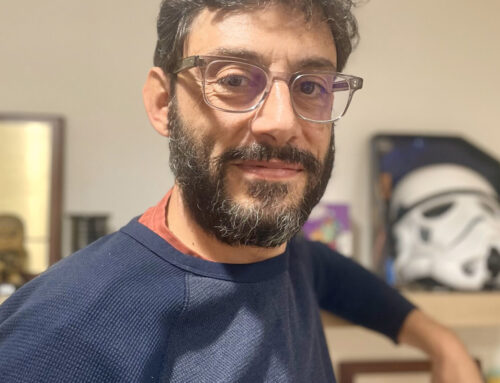In Conversation with Federico Francioni
Meet Federico Francioni, the Head of the Digital Ecosystem for Meta, the powerhouse behind Facebook, Instagram, WhatsApp, and, more recently, Quest devices and Threads.
Born in Arezzo in 1982, Federico has an impressive background in telecommunication engineering. He is a graduate of the prestigious University of Florence. He clinched victory in the Philip Morris International Challenge in 2005 and completed his academic journey in Oulu, Finland. Since 2013, Federico has made California his home, working for PwC, Microsoft, and, for the last three years, at Meta’s Menlo Park headquarters, nestled within the stunning San Francisco Bay Area, a renowned hub in the iconic Silicon Valley.
“I’m responsible for the experience design of the digital surfaces used by Meta employees globally, specifically for the internal platforms related to the human resources ecosystem, leveraging automation, personalization, and conversational technologies. We dove into the Metaverse with Federico and asked him to explain its influence on daily life”
What is Metaverse? Can you unlock the future of virtual reality?
The Metaverse is a virtual space where users can interact with each other through digital representations of themselves, known as avatars. It’s a fully immersive digital universe where people can engage in various activities, such as playing games, socializing, shopping, attending events, staying active, and working.
Why is it so relevant today?
The Metaverse is relevant because of the growing popularity of virtual and augmented reality technologies and the increasing need for digital experiences that mimic the physical world accelerated by the recent pandemic. Moreover, the Metaverse has the potential to revolutionize various industries, such as gaming, e-commerce, and education, by providing immersive and interactive experiences that were previously impossible to achieve through traditional means.
What do you think are the most unexpected applications of this technology?
VR fitness! Yes, I mean it. You can have real training in the Metaverse whenever you want, with your friends or alone, and it is incredibly intense. It was the use case that most surprised me when I started two years ago, and I’ve been hooked ever since.
Can you explain the advantages of this virtual world?
There are many. Social Interaction, for example. Virtual worlds can provide a space for people to socialize and interact with others worldwide while removing every impediment caused by physical barriers, favoring real inclusion, creativity, and self-expression. Virtual worlds often allow users to create and customize their avatars, buildings, and environments, which can encourage creativity. It’s also a fantastic instrument for education and training, providing a safe and immersive space for individuals to learn new skills or practice real-world scenarios.
What are the drawbacks and downsides?
Addiction. Spending too much time in (any) virtual world can lead to addiction and negatively impact an individual’s physical, mental, and social well-being. Also, VR devices are still relatively costly and may exclude individuals who cannot afford to participate.
In an interview, CTO Andrew Bosworth said that Meta’s CEO Mark Zuckerberg and CPO Chris Cox are spending “most” of their time working on the company’s new AI unit. Can you share any information about what comes next?
Bosworth told Nikkei that he expects Meta to debut some commercial applications using AI this year, helping the ad business. For instance, he said companies can use AI to create ads by generating several images that work for different audiences instead of relying on a single-image advertising campaign.
Is the company shifting its focus from Metaverse to generative AI?
I can’t speak of our company’s strategy, but in the same interview, Bosworth told Nikkei that Meta could also use AI in the Metaverse. “In the future, you might be able to describe the world you want to create and have the large language model generate that world for you.”
Is it already happening? Does LLaMA go in that direction?
LLaMA (Large Language Model Architecture) is a foundational language model developed by Meta AI. It is trained on a massive dataset of text and code. It can perform various tasks, including text generation (poems, code, scripts, musical pieces, email, letters, etc.), translation between 20 languages, question answering, code generation, code completion, and debugging. Across a multitude of use cases, there’s potential for this language model to code & create multiple digital assets.
Alphabet Inc. and Google Chief Executive Officer Sundar Pichai said in a CBS 60 Minutes interview: “AI can be very harmful if deployed wrongly.” What’s your take on that?
All technologies can potentially be harmful, especially when experimental and non-regulated. On top of the “typical” issues related to privacy and security, AI has a few other gray areas that need to be addressed: AI systems can reflect the biases of their creators and training data, resulting in discriminatory outcomes. For example, facial recognition technology is less accurate in identifying people with darker skin tones, which can have harmful real-world consequences. Also, AI systems have the potential to automate many jobs, which can lead to job displacement and economic inequality. If the benefits of AI are not distributed fairly, it could exacerbate existing social and economic divides. It’s essential to cautiously approach AI development and deployment and ensure appropriate regulations and safeguards are in place to mitigate potential harms with ethics in mind. When AI systems are experimental and non-regulated, it can erode public trust in the technology.
Deep fake video (DFV) is one of the most significant risks of these new technologies. How can we spot them amidst the chaos?
Detecting DFVs can be challenging. However, some signs may indicate that a video is a deepfake. I’ve read some scary stories already, so I suggest reviewing the following:
- Inconsistencies in facial movements, such as unnatural eye movements or the lack of wrinkles
- Audio and lip-syncing errors
- Inconsistencies in lighting and shadows
- Inconsistencies in the background or reflections
Is the Internet as we know it on the verge of extinction? Could the Metaverse become the new normal for our tech needs?
It will naturally evolve. Think about how we used to experience the Internet 15-20 years ago. Some of you might still remember the noise of the modem connecting to access the web via our colossal desktop computer. And here we are today, mainly with a handheld device or a watch.
Share:
Meet Federico Francioni, the Head of the Digital Ecosystem for Meta, the powerhouse behind Facebook, Instagram, WhatsApp, and, more recently, Quest devices and Threads.
Born in Arezzo in 1982, Federico has an impressive background in telecommunication engineering. He is a graduate of the prestigious University of Florence. He clinched victory in the Philip Morris International Challenge in 2005 and completed his academic journey in Oulu, Finland. Since 2013, Federico has made California his home, working for PwC, Microsoft, and, for the last three years, at Meta’s Menlo Park headquarters, nestled within the stunning San Francisco Bay Area, a renowned hub in the iconic Silicon Valley.
“I’m responsible for the experience design of the digital surfaces used by Meta employees globally, specifically for the internal platforms related to the human resources ecosystem, leveraging automation, personalization, and conversational technologies. We dove into the Metaverse with Federico and asked him to explain its influence on daily life”
What is Metaverse? Can you unlock the future of virtual reality?
The Metaverse is a virtual space where users can interact with each other through digital representations of themselves, known as avatars. It’s a fully immersive digital universe where people can engage in various activities, such as playing games, socializing, shopping, attending events, staying active, and working.
Why is it so relevant today?
The Metaverse is relevant because of the growing popularity of virtual and augmented reality technologies and the increasing need for digital experiences that mimic the physical world accelerated by the recent pandemic. Moreover, the Metaverse has the potential to revolutionize various industries, such as gaming, e-commerce, and education, by providing immersive and interactive experiences that were previously impossible to achieve through traditional means.
What do you think are the most unexpected applications of this technology?
VR fitness! Yes, I mean it. You can have real training in the Metaverse whenever you want, with your friends or alone, and it is incredibly intense. It was the use case that most surprised me when I started two years ago, and I’ve been hooked ever since.
Can you explain the advantages of this virtual world?
There are many. Social Interaction, for example. Virtual worlds can provide a space for people to socialize and interact with others worldwide while removing every impediment caused by physical barriers, favoring real inclusion, creativity, and self-expression. Virtual worlds often allow users to create and customize their avatars, buildings, and environments, which can encourage creativity. It’s also a fantastic instrument for education and training, providing a safe and immersive space for individuals to learn new skills or practice real-world scenarios.
What are the drawbacks and downsides?
Addiction. Spending too much time in (any) virtual world can lead to addiction and negatively impact an individual’s physical, mental, and social well-being. Also, VR devices are still relatively costly and may exclude individuals who cannot afford to participate.
In an interview, CTO Andrew Bosworth said that Meta’s CEO Mark Zuckerberg and CPO Chris Cox are spending “most” of their time working on the company’s new AI unit. Can you share any information about what comes next?
Bosworth told Nikkei that he expects Meta to debut some commercial applications using AI this year, helping the ad business. For instance, he said companies can use AI to create ads by generating several images that work for different audiences instead of relying on a single-image advertising campaign.
Is the company shifting its focus from Metaverse to generative AI?
I can’t speak of our company’s strategy, but in the same interview, Bosworth told Nikkei that Meta could also use AI in the Metaverse. “In the future, you might be able to describe the world you want to create and have the large language model generate that world for you.”
Is it already happening? Does LLaMA go in that direction?
LLaMA (Large Language Model Architecture) is a foundational language model developed by Meta AI. It is trained on a massive dataset of text and code. It can perform various tasks, including text generation (poems, code, scripts, musical pieces, email, letters, etc.), translation between 20 languages, question answering, code generation, code completion, and debugging. Across a multitude of use cases, there’s potential for this language model to code & create multiple digital assets.
Alphabet Inc. and Google Chief Executive Officer Sundar Pichai said in a CBS 60 Minutes interview: “AI can be very harmful if deployed wrongly.” What’s your take on that?
All technologies can potentially be harmful, especially when experimental and non-regulated. On top of the “typical” issues related to privacy and security, AI has a few other gray areas that need to be addressed: AI systems can reflect the biases of their creators and training data, resulting in discriminatory outcomes. For example, facial recognition technology is less accurate in identifying people with darker skin tones, which can have harmful real-world consequences. Also, AI systems have the potential to automate many jobs, which can lead to job displacement and economic inequality. If the benefits of AI are not distributed fairly, it could exacerbate existing social and economic divides. It’s essential to cautiously approach AI development and deployment and ensure appropriate regulations and safeguards are in place to mitigate potential harms with ethics in mind. When AI systems are experimental and non-regulated, it can erode public trust in the technology.
Deep fake video (DFV) is one of the most significant risks of these new technologies. How can we spot them amidst the chaos?
Detecting DFVs can be challenging. However, some signs may indicate that a video is a deepfake. I’ve read some scary stories already, so I suggest reviewing the following:
- Inconsistencies in facial movements, such as unnatural eye movements or the lack of wrinkles
- Audio and lip-syncing errors
- Inconsistencies in lighting and shadows
- Inconsistencies in the background or reflections
Is the Internet as we know it on the verge of extinction? Could the Metaverse become the new normal for our tech needs?
It will naturally evolve. Think about how we used to experience the Internet 15-20 years ago. Some of you might still remember the noise of the modem connecting to access the web via our colossal desktop computer. And here we are today, mainly with a handheld device or a watch.









